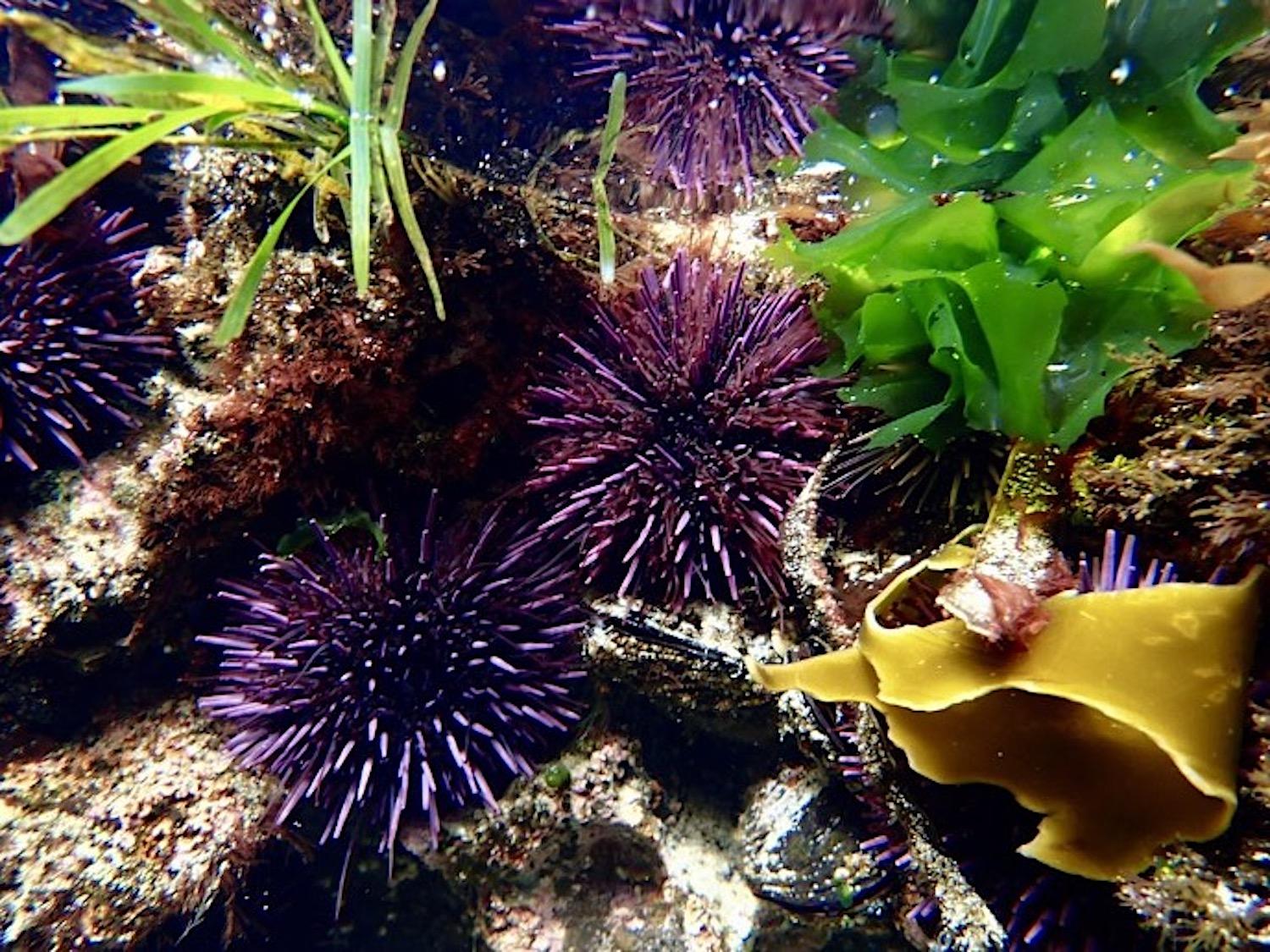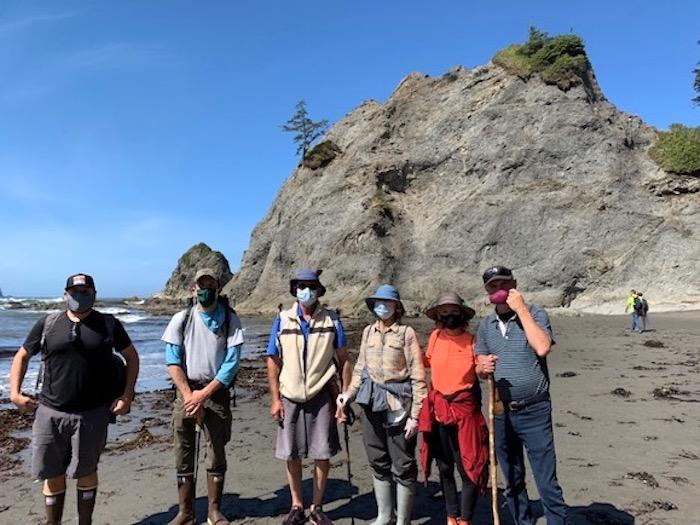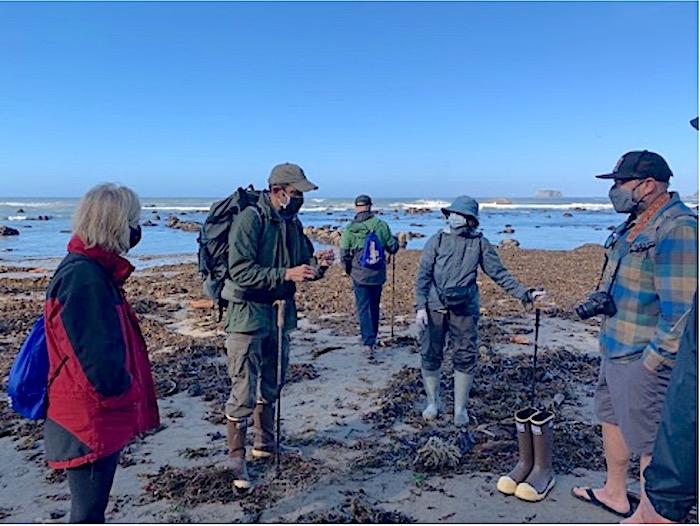
The coast of Olympic National Park is alive with marine life/WNPF
Up Close And Personal With Tidepool Critters On The Olympic Coast
By John Meyer, WNPF Board Member
Beneath the waves that roll ashore on the Olympic Coast is a symphony of life. Clinging to the rocks and going largely unnoticed by many beach visitors, a cast of characters straight out of a Sci-Fi movie busily move about. It may seem like the most hostile of environments but, to countless animals and seaweeds, it’s heaven on Earth.
Some have long limbs, others a dozen eyes. Some have soft bodies wrapped in hard shells and move lightning fast, while others move at a snail’s pace (and that’s because they’re snails). What might appear to be a rock is actually a chiton; what might appear to be a plant is actually an anemone; and what might appear to be a miniature palm tree is actually a seaweed — called the sea palm.
This mind-boggling array of life is one reason the Olympic coastline is so special. One of the most biologically diverse places in the world, the park’s intertidal zone—that area along the shore that gets covered and uncovered by the tides daily—reveals a world most of us don’t think about. But for die-hard ocean lovers, marine enthusiasts, and admirers of all things beautiful and bizarre, this ecosystem is one of the most exciting on the planet.
“Life in the intertidal zone exists alternately in two worlds, dry land and the ocean,” says Steve Fradkin, Olympic National Park’s chief marine biologist. “This netherworld is a particularly harsh, wave-swept place, yet its space is packed tighter than the busiest city with a bewildering diversity of plants and animals that have figured out how to thrive there over the eons.”

We had gathered with the park's biologist to explore the world of marine life at Olympic National Park/WNPF
On a warm summer’s day, a crew of intrepid ocean adventurers gathered at Rialto Beach to meet up with Steve and experience these tidepool wonders. Marsha Massey was the top bidder at Washington’s National Park Fund’s annual auction for a guided field trip into the intertidal realm. She rallied some friends to meet up with Steve and me, a WNPF board member and co-author of a forthcoming book about ocean life. The sun was up, the tide was out, and the explorers were ready to roll.
“I’m a life-long beach explorer and former SCUBA diver, so I am always fascinated by what lives underwater,” says Marsha. “Our Olympic Peninsula tidepools are just teeming with life, and offer a peek at the cornucopia of color, shape, movement, and rich diversity of area sea life. What a blessing to have such discovery so accessible.”
With Steve as our guide, we headed north from our parked cars at the Quillayute River towards Rialto Beach. A long walk on the gravel beach, complete with a creek crossing, led us to Hole-in-the-Wall, a natural tunnel through a giant rock outcrop that provides passage to the beach on the other side. Giant rocky sea stacks jut out from the water’s edge, revealing precious real estate for numerous sea creatures. A long bench of rock stretches out into the sea, and in its crevices you can easily spot purple sea urchins, giant orange and purple sea stars, and pink algae that looks just like coral. And that’s the easy stuff to see—a closer look reveals more.
Hermit crabs dart to and fro in the pools, almost as if they’re running late to an appointment. Sculpins sit on the pool’s bottom, holding perfectly still, until one moves and then they all do. Black turban snails plod slowly through the sand, often with hitchhikers—like limpets and other snails—latched on to their backs, all seemingly without a care in the world.
The crew pushes on from Hole-in-the-Wall to Sokol Point, where Steve checks on a long-term experiment. He’s keeping tabs on an emerging phenomenon known as ocean acidification, where carbon dioxide absorbed by the oceans worldwide is shifting seawater chemistry and threatening marine plants and animals. In some cases, studies have shown ocean acidification makes it more difficult for animals that have a shell to actually create that shell. The coasts of Washington are particularly susceptible to acidification, and Steve’s job is to help protect the ecological resources of the park.

Steve took time to explain the wide array of marine life to be seen in tidal pools/WNPF
Funding from WNPF supports Steve’s studies to monitor the issue and see how it’s affecting the biology on the coast.
“Ocean acidification is altering marine life in the Pacific Northwest and will have growing impacts in the decades to come,” says Steve. “It is critical for Olympic National Park to understand the pace and effects of ocean acidification on the diverse biota that call our shoreline home. A deeper understanding of ocean acidification will allow us to document its impacts and develop strategies to protect these cherished resources.”
As happens twice daily, the tide turns and starts covering up the shore again. We adventurers take this as our sign to head back while there is still beach to walk on. A picnic lunch awaited us back at the cars, giving us a moment to connect again and reflect on our day.
“While I have visited Hole-in-the-Wall before, this exploration was an entirely new adventure with John and Steve,” says Marsha. “To experience the Olympic coastline and tidepools with two such knowledgeable field experts was remarkable. So eye-opening and engaging and fun! We would never have known about the ocean acidification work at Sokol Point without a guide. My friends are still talking about our fantastic beach day. Thank you, WNPF, for making this opportunity available. Definitely the high point of 2020!”

This article was provided by Washington's National Park Fund, which helps make National Parks Traveler possible.
Support National Parks Traveler
National Parks Traveler is a small, editorially independent 501(c)(3) nonprofit media organization. The Traveler is not part of the federal government nor a corporate subsidiary. Your support helps ensure the Traveler's news and feature coverage of national parks and protected areas endures.
EIN: 26-2378789
A copy of National Parks Traveler's financial statements may be obtained by sending a stamped, self-addressed envelope to: National Parks Traveler, P.O. Box 980452, Park City, Utah 84098. National Parks Traveler was formed in the state of Utah for the purpose of informing and educating about national parks and protected areas.
Residents of the following states may obtain a copy of our financial and additional information as stated below:
- Florida: A COPY OF THE OFFICIAL REGISTRATION AND FINANCIAL INFORMATION FOR NATIONAL PARKS TRAVELER, (REGISTRATION NO. CH 51659), MAY BE OBTAINED FROM THE DIVISION OF CONSUMER SERVICES BY CALLING 800-435-7352 OR VISITING THEIR WEBSITE WWW.FRESHFROMFLORIDA.COM. REGISTRATION DOES NOT IMPLY ENDORSEMENT, APPROVAL, OR RECOMMENDATION BY THE STATE.
- Georgia: A full and fair description of the programs and financial statement summary of National Parks Traveler is available upon request at the office and phone number indicated above.
- Maryland: Documents and information submitted under the Maryland Solicitations Act are also available, for the cost of postage and copies, from the Secretary of State, State House, Annapolis, MD 21401 (410-974-5534).
- North Carolina: Financial information about this organization and a copy of its license are available from the State Solicitation Licensing Branch at 888-830-4989 or 919-807-2214. The license is not an endorsement by the State.
- Pennsylvania: The official registration and financial information of National Parks Traveler may be obtained from the Pennsylvania Department of State by calling 800-732-0999. Registration does not imply endorsement.
- Virginia: Financial statements are available from the Virginia Department of Agriculture and Consumer Services, 102 Governor Street, Richmond, Virginia 23219.
- Washington: National Parks Traveler is registered with Washington State’s Charities Program as required by law and additional information is available by calling 800-332-4483 or visiting www.sos.wa.gov/charities, or on file at Charities Division, Office of the Secretary of State, State of Washington, Olympia, WA 98504.

Add comment